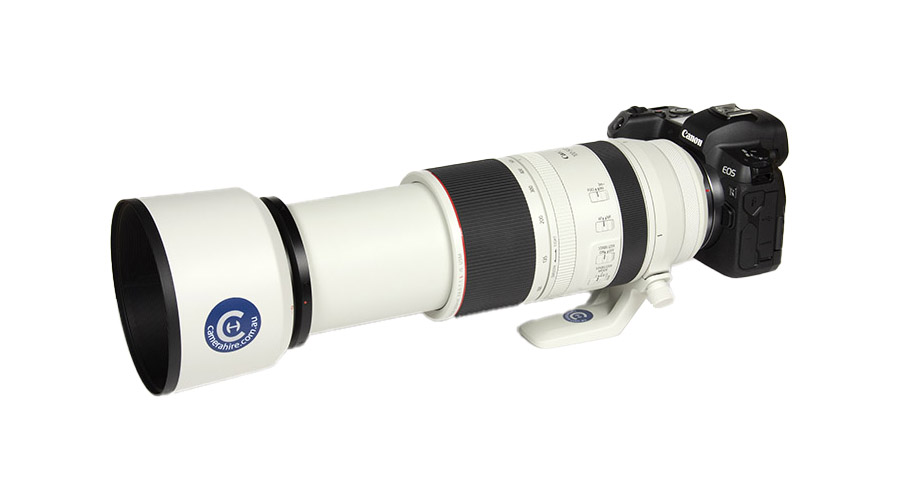Introduction
Canon has been THE dominant player in the super-telephoto arena for decades. There are many photos of sports events where you can see a myriad of white Canon L lenses in the press section. Besides lots of prime lenses, Canon has always offered moderately fast long tele-zoom lenses, with the most popular one being the EF 100-400mm f/4.5-5.6 USM L IS (II). However, during recent years this lens felt a bit conservative regarding a competition that moved on to 500mm and even 600mm at the long end. And for sports/wildlife photographers, nothing beats a long focal length but a longer one. Obviously, Canon heard the call and they upgraded their offering accordingly – the Canon RF 100-500mm f/4.5-7.1 USM L IS. This is no discount offer at around 2700USD/3100EUR which is, at least in Europe, substantially more expensive than the older DSLR lens.

Given its L-class designation, the lens is targeting professional users thus it’s not surprising that the build quality is superb. The lens body is mostly made of metal and high-quality composite materials. It extends when zooming towards the long end. This may be a bit unfortunate but combined with the rather slow speed, this results in a comparatively compact transport size at least. Fully extended to 500mm and with the attached hood, it is quite a sight though, as you can see below. The focal length can be locked in position using a dedicated adjustment ring. Besides the smoothly operating zoom and focus control rings, there’s also the usual customizable control ring near the mount. Typical for all L-class lenses, there’s extensive sealing against dust and water – and this is also needed because you are pumping lots of air in and out of the lens during zooming. The supplied tripod mount is detachable.
The Canon RF 100-500mm f/4.5-7.1 USM L IS uses an ultrasonic AF motor for focusing. The AF speed is pretty fast. A 5 f-stop optical image stabilizer is also incorporated. Its efficiency can be boosted via an in-camera image stabilizer by another stop (on the R5 and R6).

That being said, we had major issues with this lens on the EOS R. Canon released a firmware update for the EOS R AFTER the completion of the review which may have fixed our problems but during our field sessions, spot AF was unusable in certain scenes at focal lengths >350mm and the image stabilizer was not effective at longer focal lengths (soft images of static scenes at 1/500s at 500mm). For the field shots, we had to use a broader AF field and very high shutter speeds. Thus if you own an EOS R or RP and have the same issues, you should upgrade the firmware to the latest state. While you may cheer the fact that issues can be fixed via firmware, it is somewhat sad to see that this has become a requirement though.
| Specifications | |
|---|---|
| Optical construction | 20 elements in 14 groups inc. 1x SUD, 6x UD elements |
| Number of aperture blades | 9 (rounded) |
| min. focus distance | 0.9m (max magnification 1:3) |
| Dimensions | 93.8×207.9mm |
| Weight | 1370g |
| Filter size | 77mm |
| Hood | barrel-shaped, bayonet mount, supplied |
| Other features | dust- and moisture-resistant, 3-mode OSS, tripod mount, focus limiter |
Distortion
The RAW distortion characteristic of the Canon RF 100-500mm f/4.5-7.1 USM L IS is pretty good by today’s mirrorless standards. At 100mm, images are essentially free of distortions. Beyond, there’s an increasing amount of pincushion distortions with a peak of ~1.6% at 500mm.

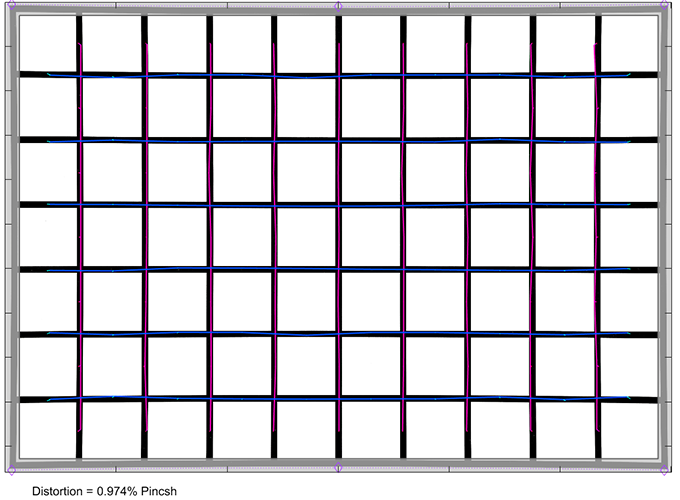
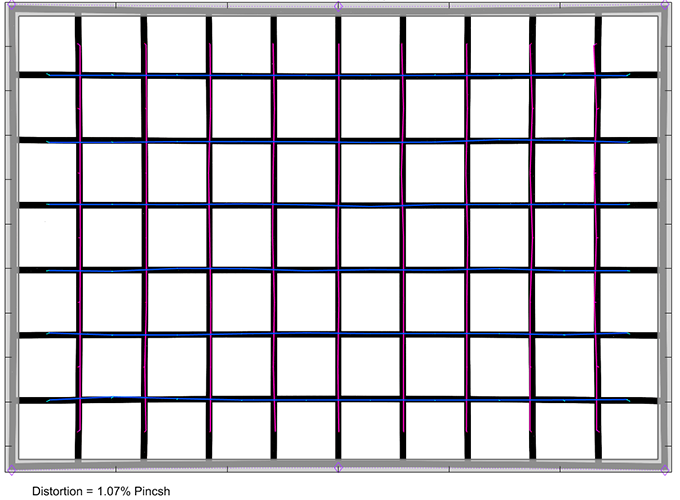
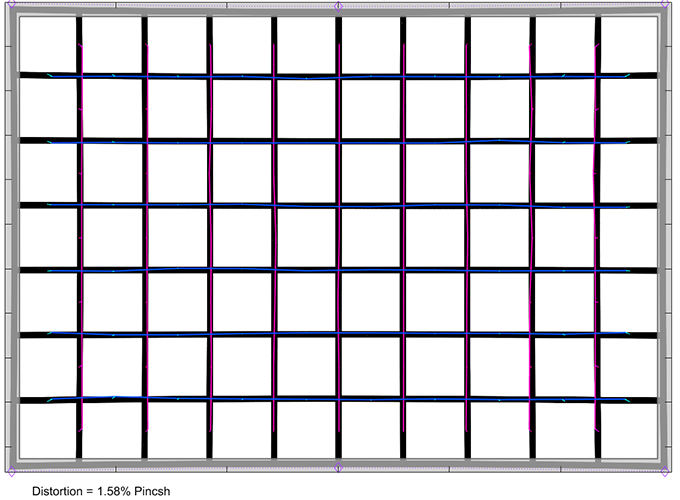
With activated image auto-correction, the distortions are very well corrected, as you can see below.


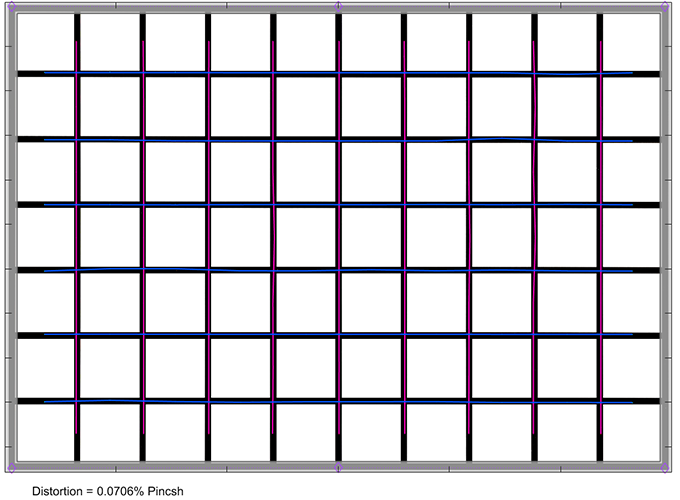

Vignetting
The RAW vignetting is typical for a super tele zoom lens. At maximum aperture, the light falloff is visible at 1-1.3EV (f-stop). Stopping down by 1 f-stop dissolves this mostly.
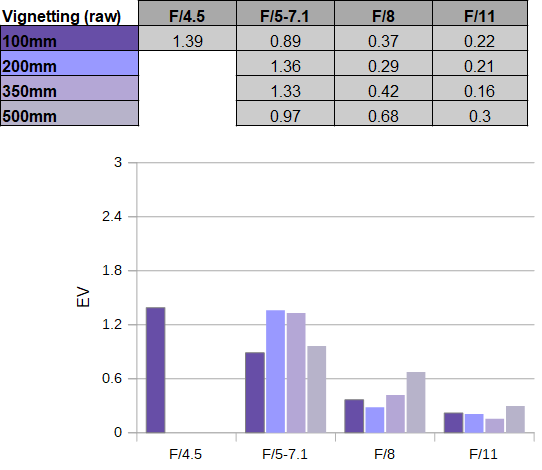
With activated image auto-correction, the light falloff is negligible by real-world standards.
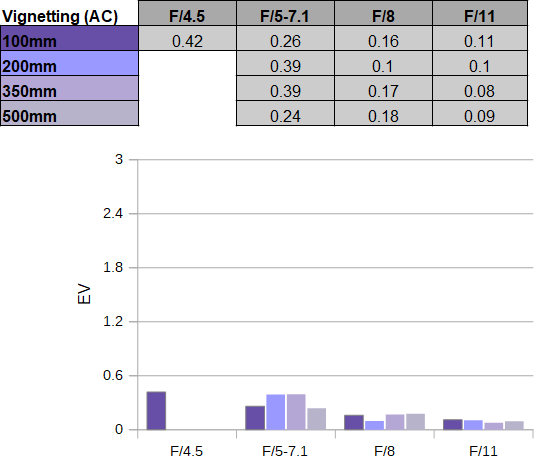
MTF (resolution)
The Canon RF 100-500mm f/4.5-7.1 USM L IS is impressively sharp throughout the range. At 100mm and 200mm the quality is on prime lens level with an excellent center and a very good to excellent outer image field. At 350mm there’s a slight decrease in quality but the quality is still very high. As you may have guessed, diffraction is limiting the performance at 500mm. A max aperture of f/7.1 is beyond the optimum aperture on full format cameras. The quality is easily very good on a 30-megapixel sensor (used for testing). On an EOS R5, it’ll be a bit more obvious in lab conditions – less so in real life.
The field curvature is very low. The centering quality of the tested sample was very good.
Please note that the MTF results are not directly comparable across the different systems!
Below is a simplified summary of the formal findings. The chart shows line widths per picture height (LW/PH) which can be taken as a measure of sharpness. If you want to know more about the MTF50 figures, you may check out the corresponding Imatest Explanations

Chromatic Aberrations (CAs)
Lateral CAs (color shadows at the image borders) are low across the range. They are hovering around an average width of 1px at the image borders which is barely noticeable in RAW files and it’s not an issue with activated image auto-correction.

Bokeh
Super-tele zoom lenses tend to have a rather busy bokeh, specifically with respect to the rendering of out-of-focus highlights. So how does the Canon RF 100-500mm f/4.5-7.1 USM L IS manage in this respect? It depends …
Out-of-focus highlights are nicely rendered. The inner disc zone is pretty clean and there’s just a slight outlining effect at the disc edges.

The shape of the highlights tends to deteriorate towards the image borders – this is due to mechanical vignetting. The Canon lens is also affected by this as you can see below. The disc in the dead center is perfectly circular, but this changes from the mid-field. The corner discs are a bit irregular in shape but avoid edgy cat eyes at least. Stopping down corrects the shape towards a circular shape.



The general rendition in the focus transition zones is very smooth in the background (shown to the left below). The foreground blur can have more distinctive shadows at harsh contrast transitions (see e.g. the nose of the king to the right below).

The above samples were taken at 100mm. However, the bokeh can vary across the zoom range. Below is a crop of a real-world image taken at a longer focal length. As you can see the rendering is quite harsh in this example. This is an extreme example but it’s not the only image where we have seen this.
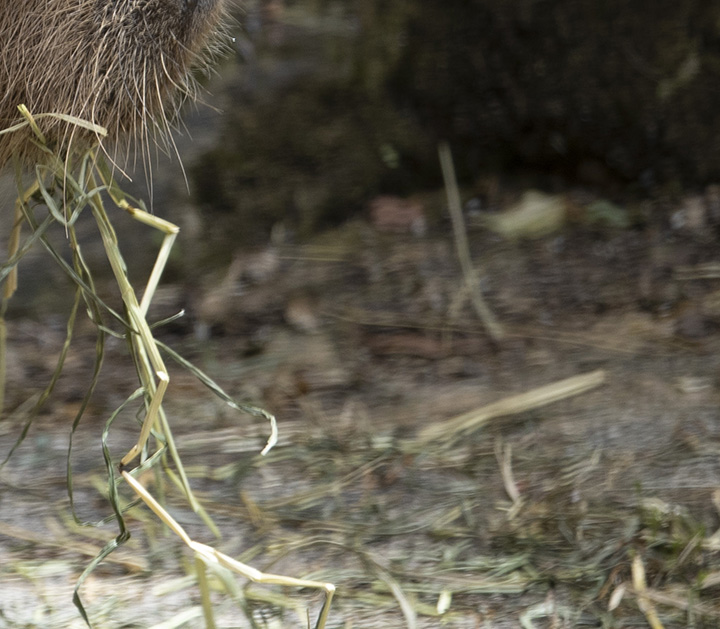
Sample Images
The Canon RF 100-500mm f/4.5-7.1 USM L IS is another impressive product in the Canon lineup and we expected no less. Within the limits of its aperture range, it is very sharp throughout the zoom range with just a minor drop towards the corners. Diffraction will somewhat limit the potential on high megapixel cameras but this won't be overly noticeable - yet. It's certainly not an issue on an EOS R or R6. The native lateral CAs are very low. Image distortions are absent at 100mm but increase a little towards the long end of the zoom range. There's also some mild vignetting at a fully-open aperture. Lateral CAs/distortions/vignetting can all be auto-corrected, of course, and the related information loss is rather limited given the good raw characteristic. The quality of the bokeh is very good in the lower zoom range but deteriorates beyond 300mm.
Canon is targeting professional users and the mechanical quality is on a correspondingly high level. The used materials are top-notch and the manufacturing precision is superb. That being said, we would have preferred a non-extending zoom mechanism. Canon implemented extensive weather-resistant but we have yet to see a lens with an extending zoom mechanism that doesn't suck in dust over time. That being said - the mechanism has the benefit of providing a fairly compact package relative to the max 500mm focal length. And Canon found some love for this approach with the RF 70-200mm f/2.8 and f/4 USM L IS as well.We had some trouble with the AF and IS combined with the EOS R but this has probably been fixed with a firmware update that came in after we finished the test already. Generally, the AF speed is pretty good and Canon's image stabilizer is among the best in the industry. If you own a camera with a built-in image stabilizer, you can also enjoy an extra gain here (+1 f-stop on the R5/R6). If you prefer to shoot from a tripod, you can take advantage of the dedicated (detachable) tripod mount on the lens - and that's also needed for keeping a decent balance in this case.
The Canon RF 100-500mm f/4.5-7.1 USM L IS is a natural choice for Canon R-mount users ... but at this stage, it's also the only native one at the time of this review. Even so - given its capabilities, it's a no-brainer if you can live with its very moderate max aperture. In order to freeze fast action at 500mm f/7.1, you will either need a lot of light and/or boost your ISO settings. Within its scope, we can still rate it as "highly recommended".
-
Optical Quality (30mp)
-
Build Quality
-
Price / Performance


